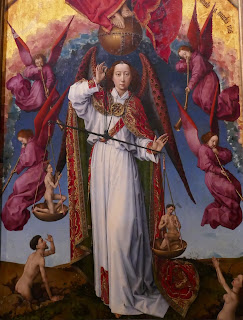Beaune, the so-called "wine capital" of Burgundy, is a town that falls into the second category. We didn't really know anything about it when we decided it might be an interesting stop-off point on our way from Hungary to visit our children in England. It turned out to be a really pretty little town which houses one of the great paintings of the world.
The painting is by Rogier van der Weyden, and was commissioned by Nicolas Rolin. A many-panelled altarpiece, it was commissioned for the hospital for paupers that Rolin established in Beaune. That hospital is astoundingly lovely and has wonderful beamed ceilings, each beam decorated with its own, highly individual face, I will spare you photographs of these, as, having attended the odd holiday snaps slide night in my time, I am aware that there are only so many pictures that anyone can absorb in one sitting.
Instead I will restrict myself to the contents of the room that houses the many-panelled altarpiece.
Here is the whole thing. As you can probably tell, it depicts the Last Judgment. The figure in red, to the left of the Virgin, is St Peter and beside him sit St John the Evangelist, and St James the Younger (?) On the right, there is St John the Baptist, St Andrew, St James the Older, St Paul, and Mary Magdalene. In the centre is the Archangel Michael, beneath Christ. Beside Christ are two inscriptions: "Come, the blessed of the Lord, to inherit the kingdom prepared for you since the beginning of the world" (Matthew 25) and "Depart from me, sinners, to the eternal fire, prepared for the devil and his lost angels" (Matthew 25).
On the left, behind St Peter, the figure in red, is a group of four men, one of whom is a pope, another a crowned male and a third a bishop. A fourth figure, who is bald, appears to have been added later. Historians agree that: the papal figure is probably Eugene IV, who gave permission for Rolin's hospital to be established; the crowned figure is probably Philippe the Good of Burgundy; the bishop is John Rolin, the son of the hospital's founder; and the bald man may be the artist himself.
The group of three women on the right are probably: Phillipote Rolin, one of the daughters of the founder of the hospital; Isabel of Portugal and Duchess of Burgundy; and either Mary Magdalene or one of Rolin's family:
In the 1870s the altarpiece was taken to the Louvre and the panels at the back were removed, so that they could be displayed separately from the front. They depict Nicolas Rolin and his wife Guigone des Salins. Rolin was born in 1376 at Autun and died in 1462. There is a wonderful painting in the Louvre by van Eyk that features him, so he clearly was a keen patron of the arts, with a good eye for the best painters working in his time, (some might argue that van Eyk and van der Weyden are among the best painters working in any time [certainly, I would]).
The red angel behind Rolin is a seraphim, which, the museum caption explained, is a rather superior rank in the hierarchy of angels and therefore is a token of the high social status of Rolin.
Rolin's wife was born in 1403 and married Rolin in 1423. When he died, she dedicated herself to the service of the poor until her own death on Christmas Eve in 1470. She is shown surrounded by Rolin family arms and symbols, including presumably the coat of arms borne by the grey winged angel.
In van der Weyden's annunciation scene on another of the altarpiece's back panels, Mary is reading the Book of Isaiah when the archangel Gabriel comes to tell her that she will give birth to the son of god. The lily beside her symbolises her virginity and the dove represents the Holy Spirit.
I marvelled at this astonishing work of art and felt, as I do so often when I look at the masterpieces of hundreds of years ago, that we cannot really claim great progress when we are now so bad at creating beauty. As I was thinking this, a rather swanky American tour guide came in with a small group of serious, well-heeled looking travellers. She nodded to the room attendant and apparently from nowhere an enormous magnifying glass glided across into the centre of the painting so that it was possible to see even more clearly the exquisite detail of the artist's skill. This kind of technology was impossible of course in the time of van der Weyden, whereas that is the achievement of our age - technological advance. It would be wrong of me to say that I would choose the ability to create beauty over the ability to create extraordinary technology, but I do wonder whether there ever had to be a trade off and why we cannot sustain both at the same time.


































No comments:
Post a Comment